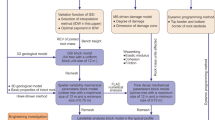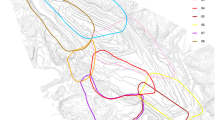Abstract
For an open-pit mine, the slope must remain stable throughout the life of mining operation, and it follows that an optimized ultimate pit limit (UPL) should have the slope stability commensurate with economic benefit. In the Shuguang gold and copper mine, a geostatistics-block-based method is used to characterize the heterogeneous mechanical properties of rock mass. Then, the detailed slope stability analyses for four possible slope configuration designs using heterogenous mechanical parameter block model are performed to determine the steepest safe slope angle, and the steepest safe slope angle is next used for the UPL optimization. Compared with the original UPL assuming the rock mass is homogeneous in the same lithology, the slope angle for the optimized UPL has an average 1° to 6° increase, and the optimized UPL can bring 15.84 million tons of ore and reduce 20.83 million tons of waste rock. The result indicated that the application of geostatistics can make practical use of geotechnical information to improve slope stability, and slope configurations, and thereby optimize the UPL and so bring economic benefit.


















Similar content being viewed by others
References
Allard D, Senoussi R, Porcu E (2016) Anisotropy models for spatial data. Math Geosci 48:305–328
Amadei B (1996) Importance of anisotropy when estimating and measuring in situ stresses in rock. International Journal of Rock Mechanics and Mining Sciences & Geomechanics Abstracts 33(3):293–325
Barclay RMR (1989) The effect of reproductive condition on the foraging behavior of female hoary bats, Lasiurus cinereus. Behav Ecol Sociobiol 24:31–37
Barton N, Lien R, Lunde J (1974) Engineering classification of rock masses for the design of tunnel support. Rock Mech 6:189–236
Bieniawski ZT (1989) Engineering rock mass classification. Wiley Interscience, New York
Bye A, Bell F (2001) Stability assessment and slope design at Sandsloot open pit, South Africa. Int J Rock Mech Min Sci 38(3):449–466
Caers J (2005) Petroleum geostatistics. Society of Petroleum Engineers, Richardson
Cai MF (2002) Rock mechanics and rock engineering. Science Press, Beijing
Cai M, Kaiser P (2018) Rockburst support reference book, volume I: rockburst phenomenon and support characteristics. MIRARCO - mining innovation. Laurentian University, Sudbury (Ontraio, Canada)
Cao WG, Zhao H, Li X, Zhang YJ (2010) Statistical damage model with strain softening and hardening for rocks under the influence of voids and volume changes. Can Geotech J 47:857–871
Chen S, Yue ZQ, Tham LG (2007) Digital image based approach for three-dimensional mechanical analysis of heterogeneous rocks. Rock Mech Rock Eng 40:145–168
Deere DU, Deere DW (1989) Rock quality designation (RQD) after twenty years. U.S. Army Corps Engrs. Contract Report GL-89-1. Vicksburg, MS: Waterways Experimental Station.
Egaña M, Ortiz JM (2013) Assessment of RMR and its uncertainty by using geostatistical simulation in a mining project. J GeoEng 8:83–90
Eivazy H, Esmaieli K, Jean R (2017) Modeling geomechanical heterogeneity of rock masses using direct and indirect geostatistical conditional simulation methods. Rock Mech Rock Eng 50:3175–3195
Fenton GA, Griffiths VD (2008) Risk assessment in geotechnical engineering. John Wiley & Sons, New York
Ferreira IO, Rodrigues DD, Santos GRD, Rosa LMF (2017) In bathymetric surfaces: IDW or kriging? Boletim de Ciências Geodésicas 23:493–508
Goovaerts P (1997) Geostatistics for natural resource evaluation environmental. Oxford University Press, New York
Hoek E (2007) Practical rock engineering. www.rocscience.com
Hoek E (2012) Blast damage factor D. Technical Note for RocNews, Winter 2012 Issue, RocScience. www.rocscience.com
Hoek E, Carranza-Torres C (2002) Hoek-Brown failure criterion—2002 edition. In: Proceedings of the fifth North American rock mechanics symposium
Hoek E, Carter TG, Diederichs MS (2013) Quantification of the geological strength index chart. In: Proc. 47th U.S. Symposium on Rock Mechanics (USRMS), 13–672, San Francisco, CA
Hustrulid W, Kuchta M (1998) Open pit mine planning and design, 2nd edn. CRC Press, London
Irigaray C, Fernández T, Chacón J (2003) Preliminary rock-slope-susceptibility assessment using GIS and the SMR classification. Nat Hazards 30:309–324
Jaeger JC, Cook NGW (2007) Fundamental of rock mechanics. Sci Paperbacks 22:1102–1111
Khalokakaie R, Downd PA, Fowell RJ (2000) Incorporation of slope design into optimal pit design algorithms. Min Technol 109:70–76
Lerchs H, Grossmann IF (1965) Optimum design of open pit mines. Canad Inst Mining Bull 58:47–54
Li LC, Tang CA, Zhu WC, Liang ZZ (2009) Numerical analysis of slope stability based on the gravity increase method. Comput Geotech 36:246–1258
Lily P (2002) Open pit mine slope engineering: a 2002 perspective. In: 150 years of mining, Proceedings of the AusIMM Annual Conference, Auckland, New Zealand
Maliva RG (2016) Aquifer characterization techniques. Springer, Switzerland
Masanobu O (1988) A method for evaluating the representative elementary volume based on joint survey of rock masses. Can Geotech J 25:440–447
Mayer JM, Stead D (2017) A comparison of traditional, step-path, and geostatistical techniques in the stability analysis of a large open pit. Rock Mech Rock Eng 50:927–949
Mccann DM, Entwisle DC (1992) Determination of Young’s modulus of the rock mass from geophysical well logs. Geol Soc Spec Publ 65(1):317–325
Myers DE (1994) Spatial interpolation: an overview. Geoderma 62:17–28
Nakaya S, Yohmei T, Koike A, Hirayama T, Yoden T, Nishigaki M (2002) Determination of anisotropy of spatial correlation structure in a three-dimensional permeability field accompanied by shallow faults. Water Resour Res 38:1–14
Olea RA (1994) Fundamentals of semivariogram estimation, modeling, and usage. In: Stochastic Modeling and Geostatistics. AAPG Computer Applications, Tulsa
Olea RA (2000) Geostatistics for engineers and earth scientists. Boston, MA: Kluwer Academic Publishers
Pinheiro M, Emery X, Miranda T, Lamas L, Espada M (2018) Modeling geotechnical heterogeneities using geostatistical simulation and finite differences analysis. Minerals 8(2):1–19
Priest SD (1993) Discontinuity analysis for rock engineering. Chapman & Hall, London
Rendu JM (1978) An introduction to geostatistical methods of mineral evaluation. South African Institute of Mining and Metallurgy, Johannesburg, South Africa
Sajid A, Rudra R, Parkin G (2013) Systematic evaluation of kriging and inverse distance weighting methods for spatial analysis of soil bulk density. Can Biosyst Eng 55:1–13
Saroglou C, Qi SY, Guo SF, Wu FQ (2018) ARMR, a new classification system for the rating of anisotropic rock masses. Bull Eng Geol Environ 78:3611–3626
Stavropoulou M, Exadaktylos G, Saratsis G (2007) A combined three-dimensional geological-geostatistical-numerical model of underground excavations in rock. Rock Mech Rock Eng 40:213–243
Tang C (1997) Numerical simulation of progressive rock failure and associated seismicity. Int J Rock Mech Min Sci 34:249–261
Xu T, Ranjith PG, Wasantha PLP, Zhao J, Tang CA, Zhu WC (2013) Influence of the geometry of partially spanning joints on mechanical properties of rock in uniaxial compression. Eng Geol 167:134–147
Yu QL, Yang SQ, Ranjith PG, Zhu WC, Yang TH (2016) Numerical modeling of jointed rock under compressive loading using X-ray computerized tomography. Rock Mech Rock Eng 49:877–891
Yu QL, Zhu WC, Ranjith PG, Shao SS (2018) Numerical simulation and interpretation of the grain size effect on rock strength. Geomech Geophys Geo 4:157–173
Yue ZQ, Chen S, Tham LG (2003) Finite element modeling of geomaterials using digital image processing. Comput Geotech 30:375–397
Zhou JR, Wei J, Yang TH, Zhu WC, Li LC, Zhang PH (2018) Damage analysis of rock mass coupling joints, water and microseismicity. Tunn Undergr Sp Tech 71:366–381
Acknowledgments
We would like to thank Professor Peijun Guo and Dylan Liu from McMaster University for their help in English writing. We also would like to thank the anonymous reviewers for their constructive comments that helped improve this manuscript.
Funding
This work was supported by the National Key Research and Development Program of China (2016YFC0801602 and 2017YFC1503101), the National Science Foundation of China (U1903216 and U1710253), and the China Scholarship Council (201806080101).
Author information
Authors and Affiliations
Corresponding author
Rights and permissions
About this article
Cite this article
Liu, F., Yang, T., Deng, W. et al. Geostatistics-block-based characterization of heterogeneous rock mass and its application on ultimate pit limit optimization: a case study. Bull Eng Geol Environ 80, 1683–1700 (2021). https://doi.org/10.1007/s10064-020-02023-2
Received:
Accepted:
Published:
Issue Date:
DOI: https://doi.org/10.1007/s10064-020-02023-2




